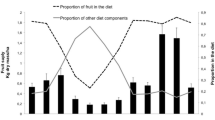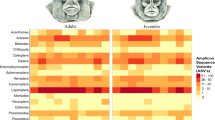Abstract
We report the diet of a wild troop of woolly monkeys (Lagothricha lagothricha lagothricha)in undisturbed rain forest in the lower Apaporis River region of southeastern Colombia during 2400 hr of observation from January 1985 through September 1987. The woolly monkey diet consisted of 78.9% fleshy fruits, 4.3% seeds, 11.4% leaves, 4.9% invertebrates, 0.1% flowers, 0.1% tendrils, and 0.3% bark. Fleshy, endozoochorus fruits were by far the most important type of food for the subjects. Intensive sampling of food plants used by L. 1. lagothrichashows floristically diverse diet including 185 species in 41 families, the most frequently used and species-rich of which are the Sapotaceae,the Moraceae, and the Mimosaceae. We compare our findings with other recent data on the three other subspecies of Lagothrixand discuss some of the ecological influences that might account for the macrogeographic similarities and differences observed in woolly monkey diets. Together, these studies provide the empirical basis for an unambiguous conclusion: Lagothrix lagothricha,classified by the IUCN as vulnerable, is a significant seed disperser throughout its extensive range. Accordingly, extinction of a population of Lagothrix isa major perturbation in its ecosystem.
Similar content being viewed by others
References
Ardila G, J. O., and Florez, A. N. (1994).Aspectos de la ecologia en un grupo silvestre de Lagothrix lagothricha lagothricha (Humboldt, 1812), Primates-Atelidae, en la amazonia colombiana, Bachelor’s thesis, Universidad Nacional de Colombia, Santafé de Bogota.
Defier, T. R. (1989). Recorrido y uso del espacio en un groupo deLagothrix lagothricha (Primates: Cebide) mono lanudo o churuco en al amazonia colombiana.TRIANEA (Act. Cient. Tecn. INDERENA) 3: 183–205.
Défier, T. R. (1994). La conservación de primates en Colombia.TRIANEA (Act. dent. Tecn. INDERENA) 5: 255–287.
Défier, T. R. (1995). The time budget in a group of wild woolly monkeys (Lagothrix lagotricha).Int J. Primatol. 16(1): 107–120.
Défier, T. R. (1996). Some aspects of the ranging pattern in a group of wild woolly monkeys (Lagothrix lagothricha).Am. J. Primatol. (in press).
Emmons, L. H. (1983). Geographic variation in densities and diversities of non-flying mammals in Amazonia.Biotropica 16(3): 210–222.
Emmons, L. H. (1990).Neotropical Rainforest Mammals: A Field Guide, University of Chicago Press, Chicago.
Fooden, J. (1963). A revision of the woolly monkeys (genusLagothrix).J. Mammal. 44: 213–247.
Gentry, A. H. (1982). Patterns of neotropical plant species diversity.Evolul Biol. 15: 1–82.
Gentry, A. H. (1986). Endemism in tropical versus temperate plant communities. In Gilpin, M. E., and Soolé, M. E. (eds.),Conservation Biology: The Science of Scarcity and Diversity, Sinauer Associates, Sunderland, MA.
Gentry, A. H. (1989). Diversidad floristica y fitogeográfica de la Amazonia. In Hernandez Camacho, J., Rodriguez, M., J. V., Chirivi, G., H., and Sanchez, P. H., (eds.),Investigación y Manejo de la Amazonia, INDERENA, Bogota, pp. 65–70.
Gentry, A. H. (1990). Floristic similarities and differences between southern Central America and upper and central Amazonia. In Gentry, A. H. (ed.),Four Neotropical Rainforests, Yale University Press, New Haven, CT, pp. 141–157.
Gentry, A. H. (1993).A Field Guide to the Families and Genera of Woody Plants of Northwest South America (Colombia, Ecuador, Peru) with Supplementary Notes on Herbaceous Taxa, Conservation International, Washington, DC.
Gentry, A. H., and Emmons, L. E. (1987). Geographical variation in fertility, phenology, and composition of the understudy of neotropical forests.Biotropica 19(3): 216–227.
Hirabuki, Y., and Izawa, K. (1990). Chemical properties of soils eaten by wild red howler monkeys (Alouatta seniculus): A preliminary study.Field Studies of New World Monkeys: La Macarena, Colombia 3: 25–28.
International Code of Zoological Nomenclature (1985). Adopted by the XX General Assembly of the International Union of Biological Sciences, Eds. W. D. L. Ride, C. W. Sabrosky, G. Bernardi, and R. V. Melville, University of California Press, Berkeley.
Izawa, K. (1993). Soil-eating byAlouatta andAteles.Int. J. Primatol. 14(2): 229–242.
McFarland Symington, M. (1988). Environmental determinants of population densities.Primate Conserv. 9: 74–79.
Milton, K. (1980).The Foraging Strategy of Howler Monkeys. A Study in Primate Economics, Columbia University Press, New York.
Muñoz, J. (1991).Algunos aspectos de la dispersión, estructura social y uso del espacio habitado en un groupo de Lagothrix lagothricha (Humboldt, 1812)-Primates, Cebidae—en la amazonia colombina, Bachelor’s thesis, Universidad Nacional de Colombia, Santafé de Bogotá.
Peres, C. A. (1994). Diet and feeding ecology of gray woolly monkeys(Lagothrix lagotricha cana) in Central Amazonia: Comparisons with other atelines.Int. J. Primatol. 15(3): 333–372.
Soini, P. (1990). Ecologia y dinámica poblacional del “Choro” (Lagothrix lagothricha), Primates) en Rio Pacaya, Peru. InLa Primatologia en el Perú, Proyecto Peruano de Primatologia, Lima, pp. 382–396.
Stevenson, P. R. (1992). Diet of woolly monkeys(Lagothrix lagotricha), at La Macarena, Colombia,Field Studies of New World Monkeys, La Macarena, Colombia 6: 3–14.
Stevenson, P. R., Quinones, M. J., and Ahumada, J. A. (1991). Relación entre la abundancia de frutos y las estrategias alimenticias de cuatro especies de primates en La Macarena, Colombia, Unpublished manuscript.
Stevenson, P. R., Quinones, M. J., and Ahumada, J. A. (1994). Ecological strategies of woolly monkeys(Lagothrix lagotricha) at Tinigua National Park, Colombia.Am. J. Primatol. 32: 123–140.
Terborgh, J. (1983).Five New World Primates: A Study in Comparative Ecology, Princeton University Press, Princeton, NJ.
Terborogh, J. (1986). Keystone plant resources in the tropical forest. In Soulé, E. E. (ed.),Conservation Biology, Sinauer, Sunderland, MA, pp. 330–344.
Terborgh, J. (1992).Diversity and the Tropical Rain Forest, Scientific American Library, W. H. Freeman, New York.
von Humboldt, A. (1812). Recueil d’observations de zoologie et d’anatomie comparée.Sur les Singes, Paris, pp. 307–344.
Author information
Authors and Affiliations
Rights and permissions
About this article
Cite this article
Defler, T.R., Defler, S.B. Diet of a group ofLagothrix Lagothricha Lagothricha in southeastern Colombia. Int J Primatol 17, 161–190 (1996). https://doi.org/10.1007/BF02735446
Received:
Accepted:
Issue Date:
DOI: https://doi.org/10.1007/BF02735446




